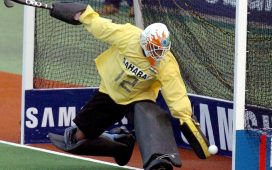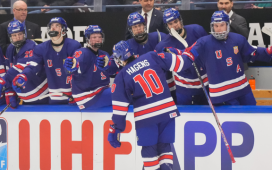It doesn’t take a doctorate in capology to connect the dots between Brayden’s Point contract with the Tampa Bay Lightning and the deal Matthew Tkachuk inked with the Calgary Flames.
The former, a three-year, $20.25-million bridge deal signed Monday, ended an impasse between player and team that had worn on for months, not weeks. And the latter, a three-year, $21-million contract inked two days later, did the same, ceasing a stalemate between Tkachuk and the Flames that was threatening to drag into the season. And all the evidence one needs that Point’s deal paved the way for Tkachuk’s pact is in the structure. Not only is the overall payment similar and the term identical, but the two contracts are almost indistinguishable in bonus money with the final year of the respective deals paying out a $9-million base salary.
This isn’t uncommon, of course. Since the dawn of the salary cap era, the word “comparable” is one that has increasingly crept into the NHL lexicon, and a market-setting contract signed by one player has generally helped dictate the contracts of others who provide similar impact. At one point, it was why a certain class of high-caliber players were locked into decade-long deals that were later deemed cap-circumventing contracts. Later, it was why second contracts for top players exiting their entry-level deals generally carried cap hits in the $6-million range. And in recent years, particularly after Connor McDavid and Leon Draisaitl resetting the bar for elite RFAs, it’s why we’ve seen second contracts grow astronomically.
But if, in the case of restricted free agents seeking bridge deals, Point’s deal set the new, did Tkachuk’s deal cement it as the clear-cut comparable for players of that ilk? And if so, what does that mean for the Winnipeg Jets and Patrik Laine, who is arguably the best RFA left without a contract for the coming campaign?
We should start by saying there are a few reasons why the question is asked of Laine and not teammate Kyle Connor or the Colorado Avalanche’s Mikko Rantanen, the most important of which is that, by all indications, Connor and Rantanen are in line for long-term pacts. Laine, on the other hand, has been pencilled in for a bridge deal for the better part of the past six months and little to nothing has changed on that front in the time since. That’s what sets him apart, because the math changes – in some cases drastically – when buying years of unrestricted free agency enters the equation.
That said, if we assume it is a bridge deal that Laine seeks, Point and Tkachuk are undoubtedly the most obvious comparables, and drawing a parallel between Point, Tkachuk and Laine, at least from an offensive perspective, isn’t as difficult as one might think. In fact, the three are for closer than one might expect.
In his three seasons in the NHL, Laine has been the superior goal scorer of the three, which should come as a surprise to no one reading this right now. In his 237 games, he’s registered 110 goals, the sixth-most in the NHL, and his stat line is complete with 74 assists to give him a 184-point total. Point, however, isn’t all that far behind in the goal category. Among the three, his 91 goals are the second-most, while his 198 points are 14 points lead the trio and put him 14 points clear of Laine. Bringing up the rear in the both goals and points in Tkachuk, with 71 goals and 174 points. Interestingly enough, though, on a per-game basis, the Flames winger’s point output is marginally – we’re talking one one-thousandth of a point – better than Laine’s per-game production. Call it a tie.
If that’s the case, though, then does it mean a simple replication of the contract handed to Tkachuk or Point is enough to get Laine’s deal done? Maybe. But maybe not.
If we dive deeper into the value of Tkachuk’s deal, and why it’s slightly richer than Point’s, one of the answers may very well be net pay. Because Florida is tax-friendly state, Point can accept a slightly lower salary – not unlike Steven Stamkos and Nikita Kucherov before him – because what he loses in annual average value he makes up for in take-home pay. (For the sake of argument, let’s ignore agent fees and signing bonuses.)
For instance, on his new deal, which carries a $6.75-million cap hit, Point is slated to earn an average of slightly more than $4 million per season. On Tkachuk’s deal with a $7-million cap hit, though, his net income is a hair less than $3.67 million. The higher AAV helps bridge the cap in actual earnings. That might be an important note here, too, because for Laine to have a net income somewhere between that of Tkachuk and Point, a three-year pact would have to pay in the $7.5-million range annually. That works out to nearly $3.75 million in take-home income for Laine, and if earnings commensurate with those who’ve put up numbers similar to his is important, that might give us an idea of what Laine’s cap hit could potentially be.
There are undoubtedly other factors to take into consideration, though. Laine has made clear his desire to play with the best players, and even if that was taken slightly out of context and twisted to become more than it really was, it speaks to some level of frustration. There’s also a matter of paying a premium for goal scoring, and Laine’s as natural a goal scorer as there is in the NHL, so much so that some feel it’s merely a matter of time before he accepts a Rocket Richard Trophy. Does that increase the price? And maybe most importantly – not necessarily to Laine, but definitely to the Jets – is the significance of cap space.
Amid Dustin Byfuglien’s indecision about his future, there’s additional financial flexibility in Winnipeg, but ideally the Jets wouldn’t see the combined spend on Laine and Connor exceed $15 million or so. Thus, if Laine signs for, say, $7.5 million per season on a three-year term, that leaves somewhere in the same range available for Connor, but on a longer-term deal. Is that enough? And if not, will Winnipeg want to try to massage either Laine or Connor’s price tag down in order to make it fit without the risk of having to scramble to move someone should Byfuglien return early in the campaign?
There are still a lot of moving parts in Winnipeg and there’s been no talk of real progress towards a contract for Laine. But if the Point and Tkachuk contracts are any indication, and both were deals that happened relatively quickly and in quick succession, maybe the Jets still have a chance to get Laine into the lineup before the season starts. All it sometimes takes is one phone call, one conversation and one offer. And maybe with something of a framework in place, it will become easier for both parties involved to figure out a way forward.
Want more in-depth features, analysis and an All-Access pass to the latest content? Subscribe to The Hockey News magazine.








